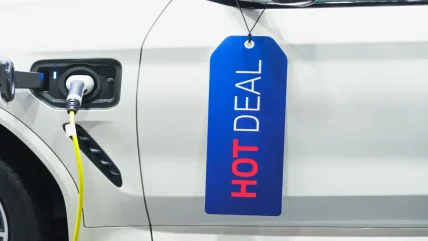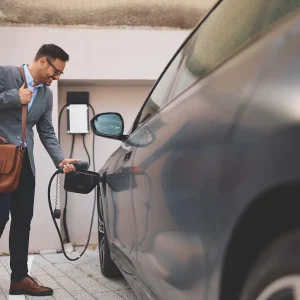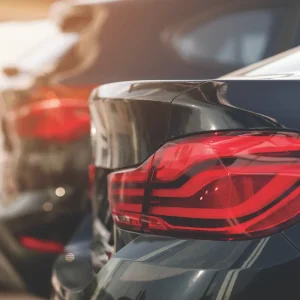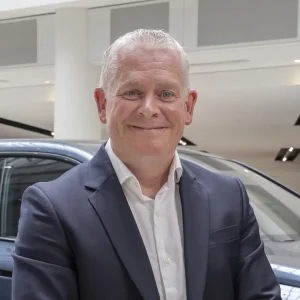
Battery state-of-health (SoH) is a real nuisance for the remarketing industry. Used car buyers do not typically worry about whether a petrol or a diesel car will match its original mpg figure, but they want to know if a second-hand EV will reach its original, quoted range or something close to it.
They have started quizzing dealers, and the lack of information – both about the battery itself and generally what is considered an acceptable degree of degradation – can leave salespeople as flummoxed as consumers.
“A dealer who rings me fairly often. said customers are now asking them ‘what is the health of that EV battery?’ and they can’t tell,” says Philip Nothard, insight director at Cox Automotive.
“Customers are now saying they don’t know whether 90% is good or bad for a two-year-old car. What does that mean? If I’m looking at a used car, is that a good price for a 90% healthy [battery] or a bad price for a 90% healthy one? That measure’s not out there yet.”
Unless you live in Scotland, which offers second-hand EV buyers an interest-free loan of up to £30,000, there is no formal consumer incentive to buy a used plug-in car. New EV sales to fleets are booming (fleet registrations rose by 38.7% in 2023 and EVs were up 17.8% overall), but turbulent used values, misinformation, and dealer buying bans, among other factors, have got the industry worried about who is going to buy them second-hand.
It has, however, started to get creative. Leasing companies, auction houses, and retail groups are now monitoring battery SoH, with a view to creating a certification scheme to illustrate the remaining battery capacity of used EVs to boost confidence among buyers.
Business Car understands several industry heavyweights are conducting trials to independently measure SoH and create an initiative akin to a used approved car scheme or an HPI check for second-hand EVs with a high level of remaining battery capacity, likely a minimum of 85-90%.
The aim is to provide transparency, foster uptake among used car buyers, and counter misinformation about EVs by providing assurance that second-hand examples are credible ownership prospects with a realistic degree of longevity.
The data is typically gathered from OBD, 12-volt, and USB sockets and companies such as Altelium, Aviloo Gmbh, ClearWatt, and Moba specialise in the practice. Telematics firms Targa Telematics and Bridgestone Mobility Solutions, which owns Webfleet, have also confirmed to Business Car that they and their contemporaries are specifically monitoring SoH.
“It’s something that we’re looking at,” says Shaun Sadlier, head of consultancy at leasing firm Arval UK, “with the second-hand market and the retail buyer in mind, we need to find a way to give them some comfort that, actually, that vehicle is going to be OK for their usage.”
“Dealers are quite a major link in the chain to give second-life vehicles some certainty,” adds AFP chair, Paul Hollick, “if they’re going to start selling EVs, beyond consumers wanting them, they need to know that they’re not going to be selling the next generation of a lemon.
“Anything the industry can do to give that level of certainty is going to be great, because I’m really worried about who’s buying second-hand and third-hand EVs and we need to try and create market stimulus.”
An equivalent battery SoH certification scheme with a near-identical objective already exists on the continent. Operated by the Car Remarketing Association Europe’s (CARA) Battery Health workgroup, it “create[s] common standards to facilitate remarketing and support residual values of used cars through trust in the battery of a BEV, easily to be communicated to buyers, by an independent assessment and certification.” Battery data specialists Aviloo Gmbh and Moba were named as approved battery health check certification suppliers to the scheme in May 2023, and the organisation also announced a secondary certification scheme for OEMs, known as the ‘Premium Test’, requirements for which were due to be released at the end of 2023, according to its website.
“The [UK] industry needs some kind of certification and it’s not necessarily, at this point, around measuring the financial value of a vehicle,” adds Nothard, “it’s more about the confidence and the transparency of information around a vehicle, but the valuation element will come.”
He suggests an independent industry-standard scheme, similar in notion to NAMA condition grading, would be optimum for the UK, but cautions that the number of companies currently exploring the concept could result in a fragmented approach.
“All the companies are testing different things, which is where we are hitting a brick wall at the minute. To get past that, what we’re saying is we need to come to an agreement that ‘these are the things you test’. and it doesn’t matter who does it. They all test the same thing, and they provide a certification of health based on those measures.”
Anecdotally, battery SoH on modern EVs is said to be good, so a percentage-based certification scheme would potentially flatter the likes of three-year-old ex-fleet vehicles – a situation that is likely to sustain or improve as the technology develops over the coming years. Research by Arval claims that an electric car with a typical multi-cell lithium-ion battery covering an average of 15,000 miles a year and 300 miles per charge would have a usable lifespan of 20 years.
However, experts note that older EVs with now-dated battery technology could have experienced greater degradation, so may not qualify for certification, assuming a required level of more than 80% capacity. Such a scheme could highlight variations in SoH between manufacturers, with new reliability reputations emerging according to each brand’s performance. All of the above could inform a vehicle’s place in the used car market, according to Nothard, who again likens it to the NAMA system.
“People will get cars from an auction and it will say, ‘that’s a grade three, that’s a grade two,’ or whatever, and you can search for them. It could be, ‘I don’t want to look at any other cars that have got less than 80% battery health’.”
Classified adverts have also come under the spotlight. They have been accused of underserving used EVs by relying on old formats based on ICE vehicle data, failing to provide EV-specific information (including SoH data), and bombarding viewers with excessive jargon.
Speaking during One Auto API’s Used EV Marketing Masterclass webinar that took place in January, Patrick Cresswell, co-founder and MD of Clearwatt explained the problem.
“There’s a lot [of classified ads] out there where you don’t even see a field for range. A lot of people are still using templates for ICE vehicles, where you see engine size and things like that which, I think, is not helping the situation.”
He adds that listing an official WLTP or NEDC range also causes confusion: “This is causing headaches, problems, and real costs. We’re hearing from a number of lease companies, for example, that early termination rates for EVs are way higher than they are for ICEs, because that misalignment of expectation can be the difference between this car suiting my lifestyle and not. And even if it’s not that clear cut, it’s really not helping the cause for EVs being a positive experience.”
In response, Clearwatt has developed a system to generate what it believes is a realistic estimated range for used EVs, which can be fed into online classified sites and included in the advert. It uses a “physics-based model” developed with the Transport Research Laboratory (TRL) which includes different vehicle characteristics based on real-world testing, a standardised set of environmental conditions (15 degrees Celsius, 70/30 split urban and highway, among others), and algorithms to predict what it believes the range should be at a certain age and mileage.
It certainly looks like a much more accurate representation of what a used EV buyer is likely to get. Couple that with a certificate guaranteeing 90% battery health, and second-hand EVs suddenly look a lot more appealing.
Supported by:






